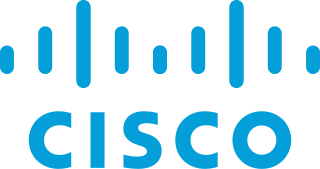
Ethernet is a family of wired computer networking technologies commonly used in local area networks (LAN), metropolitan area networks (MAN) and wide area networks (WAN). It was commercially introduced in 1980 and first standardized in 1983 as IEEE 802.3. Ethernet has since been refined to support higher bit rates, a greater number of nodes, and longer link distances, but retains much backward compatibility. Over time, Ethernet has largely replaced competing wired LAN technologies such as Token Ring, FDDI and ARCNET.
Lucent Technologies, Inc. was an American multinational telecommunications equipment company headquartered in Murray Hill, New Jersey. It was established on September 30, 1996, through the divestiture of the former AT&T Technologies business unit of AT&T Corporation, which included Western Electric and Bell Labs.

Cisco Systems, Inc.,, is an American multinational digital communications technology conglomerate corporation headquartered in San Jose, California. Cisco develops, manufactures, and sells networking hardware, software, telecommunications equipment and other high-technology services and products. Cisco specializes in specific tech markets, such as the Internet of things (IoT), domain security, videoconferencing, and energy management with leading products including Webex, OpenDNS, Jabber, Duo Security, Silicon One, and Jasper. Cisco is one of the largest technology companies in the world, ranking 82nd on the Fortune 100 with over $51 billion in revenue and nearly 83,300 employees.
Linksys Holdings, Inc., is an American brand of data networking hardware products mainly sold to home users and small businesses. It was founded in 1988 by the couple Victor and Janie Tsao, both Taiwanese immigrants to the United States. Linksys products include Wi-Fi routers, mesh Wi-Fi systems, Wifi extenders, access points, network switches, and Wi-Fi networking. It is headquartered in Irvine, California.
Enterasys Networks, Inc. was an American networking company. Enterasys products included networking equipment ranging from routers, switches, and IEEE 802.11 wireless access points and controllers. The company formed in March 2000 as a spin-off of Cabletron Systems.
SynOptics Communications was a Santa Clara, California-based early computer network equipment vendor from 1985 until 1994. SynOptics popularized the concept of the modular Ethernet hub and high-speed Ethernet networking over copper twisted-pair and fiber optic cables.

The 10 Gigabit Ethernet Alliance (10GEA) was an independent organization which aimed to further 10 Gigabit Ethernet development and market acceptance. Founded in February 2000 by a consortium of companies, the organization provided IEEE with technology demonstrations and specifications. Its efforts bore fruit with the IEEE Standards Association (IEEE-SA) Standards Board's approval in June 2002 of the IEEE 802.3 standard.
Riverstone Networks, was a provider of networking switching hardware based in Santa Clara, California. Originally part of Cabletron Systems, and based on an early acquisition of YAGO, it was one of the many Gigabit Ethernet startups in the mid-1990s. It is now a part of Alcatel-Lucent and its operations are being wound down via a Chapter 11 filing by their current owners.
Madge Networks NV was a networking technology company founded by Robert Madge, and is best known for its work with Token Ring. It was a global leader and pioneer of high-speed networking solutions in the mid-1990s, and also made significant contributions to technologies such as Asynchronous Transfer Mode (ATM) and Ethernet.
Extreme Networks, Inc., is an American networking company based in Morrisville, North Carolina. Extreme Networks designs, develops, and manufactures wired and wireless network infrastructure equipment and develops the software for network management, policy, analytics, security and access controls.
Nokia Networks is a multinational data networking and telecommunications equipment company headquartered in Espoo, Finland, and wholly owned subsidiary of Nokia Corporation. It started as a joint venture between Nokia of Finland and Siemens of Germany known as Nokia Siemens Networks. Nokia Networks has operations in around 120 countries. In 2013, Nokia acquired 100% of Nokia Networks, buying all of Siemens' shares. In April 2014, the NSN name was phased out as part of a rebranding process.
American Photonics, Inc. (API) was a very early developer of local area network technologies in the 1980s, based first in Brewster, New York, moving later to Brookfield Center, Connecticut.

Alcatel–Lucent S.A. was a multinational telecommunications equipment company, headquartered in Boulogne-Billancourt, France. It was formed in 2006 by the merger of France-based Alcatel and U.S.-based Lucent, the latter being a successor of AT&T's Western Electric and a holding company of Bell Labs.
40 Gigabit Ethernet (40GbE) and 100 Gigabit Ethernet (100GbE) are groups of computer networking technologies for transmitting Ethernet frames at rates of 40 and 100 gigabits per second (Gbit/s), respectively. These technologies offer significantly higher speeds than 10 Gigabit Ethernet. The technology was first defined by the IEEE 802.3ba-2010 standard and later by the 802.3bg-2011, 802.3bj-2014, 802.3bm-2015, and 802.3cd-2018 standards. The first succeeding Terabit Ethernet specifications were approved in 2017.
Unify is a Mitel company headquartered in Munich, Germany and is present in over 100 countries. It provides software-based enterprise unified communications including voice, Web collaboration, video conferencing and contact center, networking product and services.

The Juniper MX Series is a family of ethernet routers and switches designed and manufactured by Juniper Networks. In 2006, Juniper released the first of the MX-series, the MX960, MX240, and MX480. The second generation routers, called MX "3D", were first released in 2009 and featured a new Trio chipset and IPv6 support. In 2013, the MX routers were improved to increase their bandwidth, and a virtualized MX 3D router, the vMX 3D, was released in 2014. Utilizing the Juniper Extension Toolkit (JET), third party software can be integrated into the routers.

Accton Technology Corporation is a Taiwanese company in the electronics industry that primarily engages in the development and manufacture of networking and communication solutions, as an original equipment manufacturer (OEM) or original design manufacturer (ODM) partner.

Ixia was a public computer networking company operating in around 25 countries until its acquisition by Keysight Technologies Inc. in 2017. Ixia was headquartered in Calabasas, California and had approximately 1,750 employees.







